SEO
15 Project Management Tools For SEO Professionals

Search engine optimization is complex.
Between changes to search algorithms, new keywords, and strategic changes made by competitors, the field is in a constant state of flux.
If you’re like most SEO pros, at any given time, you’re juggling numerous projects, plans, and tasks.
Just staying organized can feel like a full-time job in itself.
Luckily, you can put technology to work for you in the form of project management (PM) tools.
Why SEO Professionals Need Project Management Tools
If you’re already using a project management platform, you undoubtedly recognize the benefits it provides for busy digital marketers and web teams.
If you’re still getting by without one, you should get one as soon as possible. Why you ask?
Because it can uncomplicate your life and help you get more done in less time.
Some of the essential functions a good project management platform provides for SEO professionals are:
- Accurate planning. From a bird’s eye view of all your campaigns to detailed information on how a specific keyword performs, SEO project management software allows you to create structured plans.
- Task and time management. Whether you’re working solo or as part of a team, PM tools allow you to assign tasks and receive notifications about them, so you can more accurately work hours. This can also be used to generate accurate invoices for your clients.
- Resource allocation. An SEO PM software will give you at-a-glance information about where your budget and resources are going. Useful for SEO, it’s also extremely helpful if you’re also running pay-per-click ads.
- Reporting. Most modern PM platforms offer robust reporting features and dashboards, so you can generate and analyze data to improve efficiency.
It’s easy to see why so many SEO professionals have turned to PM platforms to help them stay organized and productive, but there are a lot of options.
How do you know which one is right for you and your team?
We’ve compiled a list of some of the top ones. Below, you’ll find our choices for the 15 best PM tools with a brief overview of each, including pros and cons.
Our Top 15 Project Management Platforms For SEO
1. Asana
The PM platform used by Search Engine Journal, Asana is a personal favourite.
This cloud-based platform provides a virtual workspace from which your team and various stakeholders can collaborate.
It’s useful for SEO and digital marketing because it allows you to clearly set and manage strategies, goals, tasks, and expectations.
Why It’s Good For SEO:
- Task management: Using the forms feature, you can create standard workflows customized to your SEO processes.
- Automated workflow: Rules-based automation can replace tedious manual tasks.
- Reporting features: Asana has dashboards, charts, and graphs with real-time reporting, so you can get a high-level view or dive into the details.
- Free for up to 15 users: Asana has a free tier that can be used by teams of 15 or less. It includes unlimited tasks, messages, projects, and 100MB of storage for each user.
- Integrations: Asana plays nice with more than 100 other apps and platforms, including Microsoft Office, Dropbox, and Salesforce.
Potential Drawbacks For SEO:
- Unintuitive design: If you’ve never used Asana before, it can be a little challenging to figure out. However, once you’ve mastered the learning curve, it’s quite easy to use.
- No time tracking functionality: There is no built-in time tracking functionality in this platform. This can cause complications in billing clients or resource allocation.
- Not ideal for small teams: With a range of advanced features and capabilities, it can be overwhelming for small teams or limited SEO projects.
2. Monday.com
Garfield may hate Mondays, but SEO professionals who use Monday.com for project management sure don’t.
With an operating system that can be customized to your preferred workflow, it’s a great choice for smaller SEO teams looking for a tool to help them stay on track.
Why It’s Good For SEO:
- Clean user interface: Monday.com has a clean interface that allows you to customize your dashboard and extend data in columns. You can easily get multiple views of an SEO project including calendars, Kanban boards, and collateral.
- Templates: Monday.com has many templates to choose from, so you will likely find one that matches your workflow.
- Notifications and communication: This platform streamlines team communication. Team members can leave comments on tasks or documents and stakeholders can be notified via email.
Potential Drawbacks For SEO:
- Steep learning curve: Like many PM platforms, it can be challenging to get the hang of Monday.com. Bigger tasks with more communication can begin to get a bit unwieldy.
- Slow dashboard loading: It can take some time for your Monday.com dashboard to load, particularly on larger projects where a lot of data has to be transferred from its servers to your computer.
- Client licenses not included: If you want to invite clients to participate in your workspace, you will need to buy a license for them.
3. GanttPro
For more than a century, PM professionals have been using Gantt Charts to track their project schedules.
GanttPro is a web-based PM solution based around these visual trackers.
Why It’s Good For SEO:
- Readily understandable: You don’t have to have a project management certificate to track tasks with GanttPro. It gives you status information in an easy-to-understand visual format.
- Undo functionality: A simple mistake doesn’t have to derail your project because this tool saves your history and lets you undo actions with CTRL + Z.
- Customizable fields: You can create custom fields for every task.
Potential Drawbacks For SEO:
- Not as many integrations: Unlike other PM platforms, GanttPro is light on integrations with other apps.
- No billing or invoicing tools: You will need an outside program to generate invoices for your SEO services.
- Manual date input: Changing dates for benchmarks and project completion must be input manually, which some users find tedious.
4. Trello
One of the most popular platforms for project management, Trello uses boards, lists, and cards to help keep you organized.
With a free basic plan, it is useful for SEO teams of all sizes.
Why It’s Good For SEO:
- Free basic plan: Your entire team can try Trello for free. If you like it, there are premium plans available that add integrations, automation, and other functionality.
- Intuitive Kanban boards: Trello’s drag-and-drop card system makes it easy to track the status of any project.
- Useful for campaigns of all sizes: Trello works just as well for huge, complex campaigns as it does for simple projects.
Potential Drawbacks For SEO:
- Kanban-reliant: If you don’t like to use Kanban boards, this is not the PM tool for you, as most of its functionality is built around them.
- Upload sizes limited: Trello restricts free users to 10 MB of online storage and paid users to 250 MB. For most SEO teams this probably won’t be a problem, but you may differ.
- Timeline relationships are not always clear: Trello does not allow users to manipulate relationships for a better understanding of how they work together.
5. Teamwork
Another Kanban-based PM tool, Teamwork offers a drag-and-drop interface with more advanced reporting features.
Teamwork lets you create custom branding accounts, which is useful if you’re working on more than one client.
Why It’s Good For SEO:
- Unlimited users: You can add any number of users to a single task.
- Clear vision of scope: Teamwork’s board view makes it easy to understand what is going on with each project.
- Repeating tasks: Teamwork lets you simply copy any task, which is especially useful for SEO professionals.
Potential Drawbacks For SEO:
- Can be overwhelming: The upside is Teamwork has a lot of features. The downside is all those features can get confusing, especially when you’re a new user.
- No in-platform chat functionality: You’ll need to use an outside app to “chat” with your team and/or stakeholders.
6. Zoho Projects
A cloud-based platform, Zoho Projects provides the functionality you need to manage several SEO projects at once.
You can choose from a limited free version with basic features and four premium plans with different features and user caps.
Why It’s Good For SEO:
- Communication tools: Zoho Project has real-time chat and forum pages, so you can quickly and easily share information with your team.
- Timekeeping: If you bill your SEO clients by the hour, this platform is a good choice because it has excellent time tracking functionality.
- At-a-glance-info: Zoho makes it easy to spot delays, lags, and bottlenecks.
Potential Drawbacks For SEO:
- Features can be overwhelming: Because it offers so much functionality, some users may be intimidated by this PM platform. It also has a steeper learning curve.
- Inflexible: It can be difficult to customize projects to your needs with this platform.
7. Wrike
Wrike can help you simplify planning while keeping your SEO projects on track.
Customizable workflows and ample communication options help you reduce emails, meetings and status updates.
Why It’s Good For SEO:
- Task prioritization: With Wrike, you can push critical tasks to the front to make sure you don’t miss deadlines.
- Natural workflow: Wrike is structured in a way most people will find logical and easy to use.
- Advanced features: Functionality for task management, Gantt charts and real-time newsfeed is built-in.
Potential Drawbacks For SEO:
- Pricier than some options: There is a free version available with limited functionality, but premium plans with more functions are more expensive than other PM tools.
- Difficult onboarding new users: Adding new users and assigning tasks to them must be done manually, which can be time-consuming.
- Can be difficult to navigate: Users who are unfamiliar with Wrike may have difficulty navigating projects.
8. Smartsheet
With project and work management tools, Smartsheet is an online work execution platform that allows you to automate tasks and generate real-time visuals, including Gantt charts and dashboards.
Why It’s Good For SEO:
- Robust communication and collaboration: Smartsheet makes it easy to create and implement communication plans.
- Adding tasks and dependencies: Smartsheet has an intuitive design that allows you to add tasks and dependencies with ease.
- Custom dashboards: Set up your dash to display the information you want.
Potential Drawbacks For SEO:
- Doesn’t support detailed documents: Users are only allowed to upload 10 documents per ticket, which can be troublesome for highly specific campaigns.
- May be too simple for larger teams: If you’re overseeing a big team with many stakeholders, you may find this platform doesn’t include all the functionality you want.
9. Celoxis
Designed to be an all-in-one PM platform for enterprise-level organizations, Celoxis has nearly all the functionality an SEO professional could ever want.
It has high-level visibility and numerous reports, to help your campaigns stay on track and on budget.
Why It’s Good For SEO:
- Easy to use: Celoxis gives you the tools to dive deep into a project, without sacrificing usability. It’s also easy to set up.
- Includes time tracking, resource management, and budgeting: It also has ample reporting features to keep you on track.
- Good value: Celoxis offers the functionality of a top-tier PM platform at the price point of a mid-tier one.
Potential Drawbacks For SEO:
- No billing or invoicing functionality: You will have to use an outside program to bill your clients.
- No free version: If you’re looking for a free-to-use PM platform for your SEO team, this isn’t it.
10. ProofHub
ProofHub doesn’t have as many features as some other PM platforms, but it’s still a good fit for SEO.
It provides a centralized hub for task lists, workflows, calendars, and documents.
Why It’s Good For SEO:
- All the tools you need: ProofHub gives you everything you need for SEO planning, team collaboration, and management.
- Unlimited users: You can add as many people to the platform as you need.
- Communication: All discussions can be centralized in one place thanks to built-in chat and document sharing features.
Potential Drawbacks For SEO:
- Recurring tasks must be entered manually: ProofHub does not provide you with the option to repeat tasks.
- No budgeting: You will need to use a third-party platform to oversee budgeting for your SEO tasks.
11. ClickUp
ClickUp is a cloud-based platform that combines centralized company information and business tools in one place.
It allows you to create and manage to-do lists, workflows, and schedules in a variety of formats.
Why It’s Good For SEO:
- Easy to use: ClickUp has a short learning curve, meaning you and your team can start benefiting from it faster.
- Multiple views: Track your campaigns via a list, board, calendar, and workload view, among others.
- Perfect balance of functions and ease of use: ClickUp falls in the Goldilocks zone by including the features you want without the complexity.
Potential Drawbacks For SEO:
- Navigation can be confusing: The differences between tabs is subtle.
- Implementation can require significant planning: Because it’s highly customizable, you may have to systematically plan workflows to maximize ClickUp’s benefits.
12. Forecast
With Forecast, you can put all your SEO projects, resources, and budgeting in one convenient tool.
An AI-native platform can significantly reduce your administrative workload.
Why It’s Good For SEO:
- Easily track the lifecycle of projects: You can assign and allocate tasks and budget for your entire SEO PM operation through this platform.
- Schedule visualization: You can get information on a team member’s workload at a glance.
- Gathering data is easy: Want to compare a current campaign to an old one? Forecast makes it easy to pull data.
Potential Drawbacks For SEO:
- Updating time and task entries can be tedious: Manual entry can be a time-consuming process.
- Not ideal for larger teams: Visualization elements can be overwhelming if you have a lot of people working under you.
13. Adobe Workfront
Adobe’s solution for project management needs, Workfront is configurable to your needs and includes extensive integrations, so you can easily track the latest developments in your SEO projects.
Why It’s Good For SEO:
- Well-designed user interface: Workfront is easy to use and visually appealing.
- Real-time information: It keeps you abreast of any status changes.
- Good transparency: This platform helps eliminate confusion about who is supposed to do what, as stakeholders and project scope are easily visible.
Potential Drawbacks For SEO:
- Lengthy setup process: A high level of customization means Workfront requires a more in-depth initial setup.
- May offer too much detail: With Workfront, you can get as granular into tasks as you like, which may lead to some people becoming lost in the details.
- Finding tasks can be difficult: If you don’t know what project a task is assigned to, it can be difficult to locate.
14. WorkOtter
With WorkOtter, you can plan resources for your SEO campaigns at a project, rather than task level.
One of the easiest PM platforms to use, it’s an excellent choice for SEO work.
Why It’s Good For SEO:
- Very easy to use: You don’t have to be a tech wiz to use WorkOtter for SEO project management.
- Good communication and reporting tools: Real-time information keeps your entire team on the same page.
- Good for resource management: This platform is useful for deciding exactly where your SEO resources will be allocated.
Potential Drawbacks For SEO:
- Cloud-only: There is no local version available, which can be problematic if you are trying to work offline.
- English-only support: This may present challenges for non-native English speakers.
15. PSOHub
This versatile PM platform is as useful for SEO teams as it is for architect firms or financial companies.
It has predictive project management to allow you to more accurately project how your SEO campaigns will run.
Why It’s Good For SEO:
- Excellent time tracking functionality: PSOHub is one of the best platforms for tracking where your team’s time is going, on both group and individual levels.
- CRM Integrations: This platform integrates with Hubspot and other CRMs, so you can track your SEO campaigns alongside email initiatives.
- Flexible reporting: PSOHub lets you choose the data you want to include in reports.
Potential Drawbacks For SEO:
- Time-consuming setup process: It can take some time to manually enter all your campaigns and tasks into this platform.
- All users must have the same license level: You cannot have some users on a basic level and others on a more complex one.
How To Pick The Right PM Tool For Your SEO Needs
We’ve given you 15 different project management options that can work for your needs as an SEO professional. But how do you pick the right one for you?
It all comes down to your specific needs. Any of these platforms will help you streamline your operations, manage campaigns more effectively, and eliminate wasted time. But each of them has slightly different functionality.
It’s up to you to decide what will work best for your needs. But hopefully, by this point, we’ve given you enough information to get started.
Featured Image: Paulo Bobita/Search Engine Journal
SEO
How To Write ChatGPT Prompts To Get The Best Results

ChatGPT is a game changer in the field of SEO. This powerful language model can generate human-like content, making it an invaluable tool for SEO professionals.
However, the prompts you provide largely determine the quality of the output.
To unlock the full potential of ChatGPT and create content that resonates with your audience and search engines, writing effective prompts is crucial.
In this comprehensive guide, we’ll explore the art of writing prompts for ChatGPT, covering everything from basic techniques to advanced strategies for layering prompts and generating high-quality, SEO-friendly content.
Writing Prompts For ChatGPT
What Is A ChatGPT Prompt?
A ChatGPT prompt is an instruction or discussion topic a user provides for the ChatGPT AI model to respond to.
The prompt can be a question, statement, or any other stimulus to spark creativity, reflection, or engagement.
Users can use the prompt to generate ideas, share their thoughts, or start a conversation.
ChatGPT prompts are designed to be open-ended and can be customized based on the user’s preferences and interests.
How To Write Prompts For ChatGPT
Start by giving ChatGPT a writing prompt, such as, “Write a short story about a person who discovers they have a superpower.”
ChatGPT will then generate a response based on your prompt. Depending on the prompt’s complexity and the level of detail you requested, the answer may be a few sentences or several paragraphs long.
Use the ChatGPT-generated response as a starting point for your writing. You can take the ideas and concepts presented in the answer and expand upon them, adding your own unique spin to the story.
If you want to generate additional ideas, try asking ChatGPT follow-up questions related to your original prompt.
For example, you could ask, “What challenges might the person face in exploring their newfound superpower?” Or, “How might the person’s relationships with others be affected by their superpower?”
Remember that ChatGPT’s answers are generated by artificial intelligence and may not always be perfect or exactly what you want.
However, they can still be a great source of inspiration and help you start writing.
Must-Have GPTs Assistant
I recommend installing the WebBrowser Assistant created by the OpenAI Team. This tool allows you to add relevant Bing results to your ChatGPT prompts.
This assistant adds the first web results to your ChatGPT prompts for more accurate and up-to-date conversations.
It is very easy to install in only two clicks. (Click on Start Chat.)
For example, if I ask, “Who is Vincent Terrasi?,” ChatGPT has no answer.
With WebBrower Assistant, the assistant creates a new prompt with the first Bing results, and now ChatGPT knows who Vincent Terrasi is.
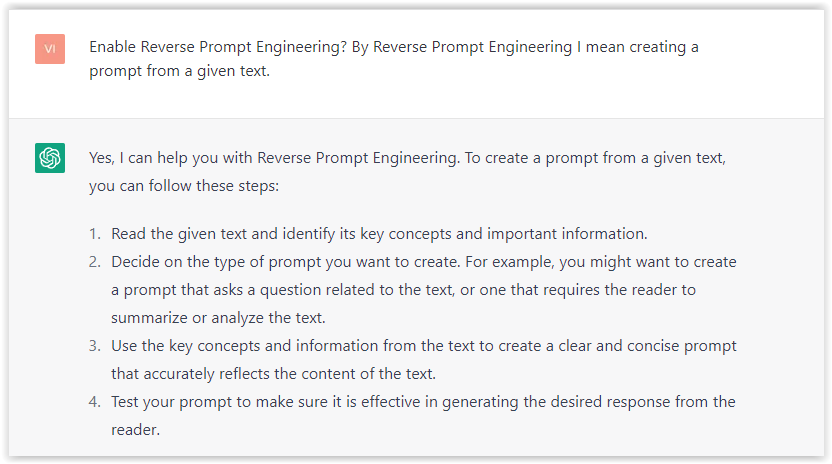 Screenshot from ChatGPT, March 2023
Screenshot from ChatGPT, March 2023You can test other GPT assistants available in the GPTs search engine if you want to use Google results.
Master Reverse Prompt Engineering
ChatGPT can be an excellent tool for reverse engineering prompts because it generates natural and engaging responses to any given input.
By analyzing the prompts generated by ChatGPT, it is possible to gain insight into the model’s underlying thought processes and decision-making strategies.
One key benefit of using ChatGPT to reverse engineer prompts is that the model is highly transparent in its decision-making.
This means that the reasoning and logic behind each response can be traced, making it easier to understand how the model arrives at its conclusions.
Once you’ve done this a few times for different types of content, you’ll gain insight into crafting more effective prompts.
Prepare Your ChatGPT For Generating Prompts
First, activate the reverse prompt engineering.
- Type the following prompt: “Enable Reverse Prompt Engineering? By Reverse Prompt Engineering I mean creating a prompt from a given text.”
 Screenshot from ChatGPT, March 2023
Screenshot from ChatGPT, March 2023ChatGPT is now ready to generate your prompt. You can test the product description in a new chatbot session and evaluate the generated prompt.
- Type: “Create a very technical reverse prompt engineering template for a product description about iPhone 11.”
 Screenshot from ChatGPT, March 2023
Screenshot from ChatGPT, March 2023The result is amazing. You can test with a full text that you want to reproduce. Here is an example of a prompt for selling a Kindle on Amazon.
- Type: “Reverse Prompt engineer the following {product), capture the writing style and the length of the text :
product =”
 Screenshot from ChatGPT, March 2023
Screenshot from ChatGPT, March 2023I tested it on an SEJ blog post. Enjoy the analysis – it is excellent.
- Type: “Reverse Prompt engineer the following {text}, capture the tone and writing style of the {text} to include in the prompt :
text = all text coming from https://www.searchenginejournal.com/google-bard-training-data/478941/”
 Screenshot from ChatGPT, March 2023
Screenshot from ChatGPT, March 2023But be careful not to use ChatGPT to generate your texts. It is just a personal assistant.
Go Deeper
Prompts and examples for SEO:
- Keyword research and content ideas prompt: “Provide a list of 20 long-tail keyword ideas related to ‘local SEO strategies’ along with brief content topic descriptions for each keyword.”
- Optimizing content for featured snippets prompt: “Write a 40-50 word paragraph optimized for the query ‘what is the featured snippet in Google search’ that could potentially earn the featured snippet.”
- Creating meta descriptions prompt: “Draft a compelling meta description for the following blog post title: ’10 Technical SEO Factors You Can’t Ignore in 2024′.”
Important Considerations:
- Always Fact-Check: While ChatGPT can be a helpful tool, it’s crucial to remember that it may generate inaccurate or fabricated information. Always verify any facts, statistics, or quotes generated by ChatGPT before incorporating them into your content.
- Maintain Control and Creativity: Use ChatGPT as a tool to assist your writing, not replace it. Don’t rely on it to do your thinking or create content from scratch. Your unique perspective and creativity are essential for producing high-quality, engaging content.
- Iteration is Key: Refine and revise the outputs generated by ChatGPT to ensure they align with your voice, style, and intended message.
Additional Prompts for Rewording and SEO:
– Rewrite this sentence to be more concise and impactful.
– Suggest alternative phrasing for this section to improve clarity.
– Identify opportunities to incorporate relevant internal and external links.
– Analyze the keyword density and suggest improvements for better SEO.
Remember, while ChatGPT can be a valuable tool, it’s essential to use it responsibly and maintain control over your content creation process.
Experiment And Refine Your Prompting Techniques
Writing effective prompts for ChatGPT is an essential skill for any SEO professional who wants to harness the power of AI-generated content.
Hopefully, the insights and examples shared in this article can inspire you and help guide you to crafting stronger prompts that yield high-quality content.
Remember to experiment with layering prompts, iterating on the output, and continually refining your prompting techniques.
This will help you stay ahead of the curve in the ever-changing world of SEO.
More resources:
Featured Image: Tapati Rinchumrus/Shutterstock
SEO
Measuring Content Impact Across The Customer Journey

Understanding the impact of your content at every touchpoint of the customer journey is essential – but that’s easier said than done. From attracting potential leads to nurturing them into loyal customers, there are many touchpoints to look into.
So how do you identify and take advantage of these opportunities for growth?
Watch this on-demand webinar and learn a comprehensive approach for measuring the value of your content initiatives, so you can optimize resource allocation for maximum impact.
You’ll learn:
- Fresh methods for measuring your content’s impact.
- Fascinating insights using first-touch attribution, and how it differs from the usual last-touch perspective.
- Ways to persuade decision-makers to invest in more content by showcasing its value convincingly.
With Bill Franklin and Oliver Tani of DAC Group, we unravel the nuances of attribution modeling, emphasizing the significance of layering first-touch and last-touch attribution within your measurement strategy.
Check out these insights to help you craft compelling content tailored to each stage, using an approach rooted in first-hand experience to ensure your content resonates.
Whether you’re a seasoned marketer or new to content measurement, this webinar promises valuable insights and actionable tactics to elevate your SEO game and optimize your content initiatives for success.
View the slides below or check out the full webinar for all the details.
SEO
How to Find and Use Competitor Keywords

Competitor keywords are the keywords your rivals rank for in Google’s search results. They may rank organically or pay for Google Ads to rank in the paid results.
Knowing your competitors’ keywords is the easiest form of keyword research. If your competitors rank for or target particular keywords, it might be worth it for you to target them, too.
There is no way to see your competitors’ keywords without a tool like Ahrefs, which has a database of keywords and the sites that rank for them. As far as we know, Ahrefs has the biggest database of these keywords.
How to find all the keywords your competitor ranks for
- Go to Ahrefs’ Site Explorer
- Enter your competitor’s domain
- Go to the Organic keywords report
The report is sorted by traffic to show you the keywords sending your competitor the most visits. For example, Mailchimp gets most of its organic traffic from the keyword “mailchimp.”


Since you’re unlikely to rank for your competitor’s brand, you might want to exclude branded keywords from the report. You can do this by adding a Keyword > Doesn’t contain filter. In this example, we’ll filter out keywords containing “mailchimp” or any potential misspellings:
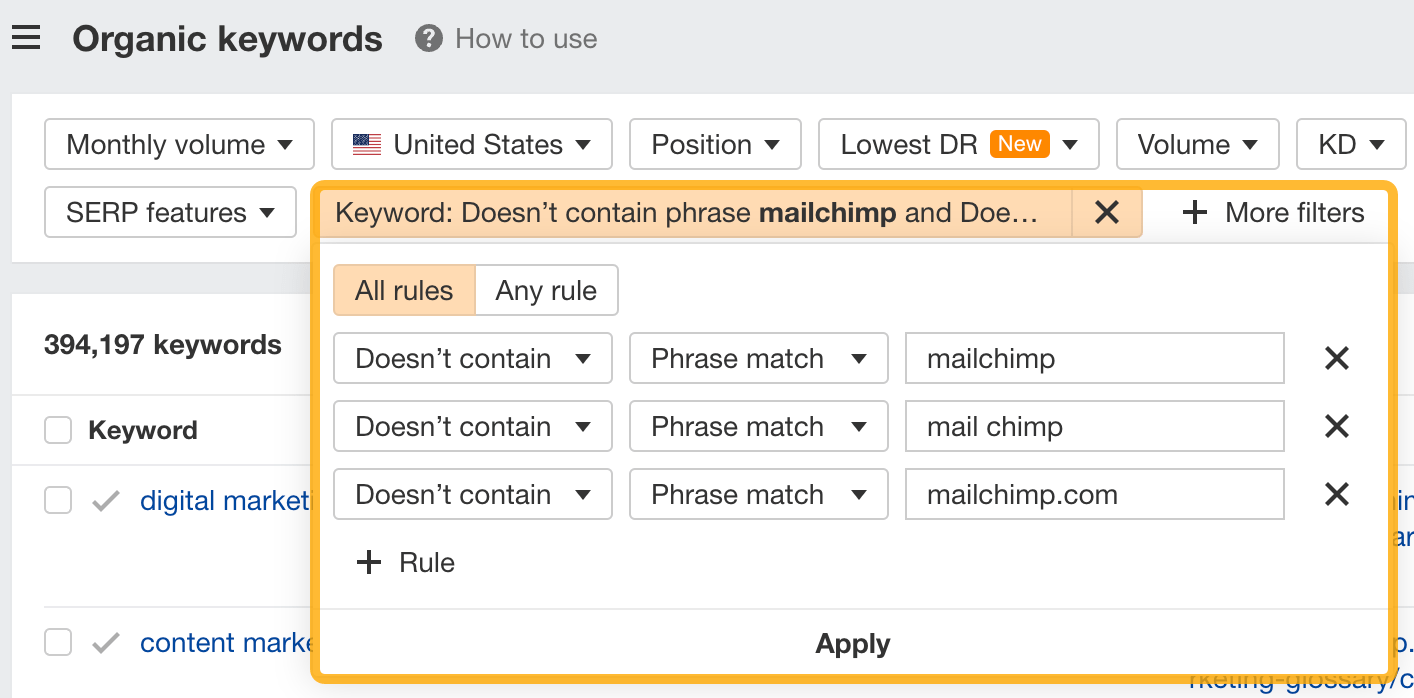

If you’re a new brand competing with one that’s established, you might also want to look for popular low-difficulty keywords. You can do this by setting the Volume filter to a minimum of 500 and the KD filter to a maximum of 10.


How to find keywords your competitor ranks for, but you don’t
- Go to Competitive Analysis
- Enter your domain in the This target doesn’t rank for section
- Enter your competitor’s domain in the But these competitors do section


Hit “Show keyword opportunities,” and you’ll see all the keywords your competitor ranks for, but you don’t.


You can also add a Volume and KD filter to find popular, low-difficulty keywords in this report.


How to find keywords multiple competitors rank for, but you don’t
- Go to Competitive Analysis
- Enter your domain in the This target doesn’t rank for section
- Enter the domains of multiple competitors in the But these competitors do section
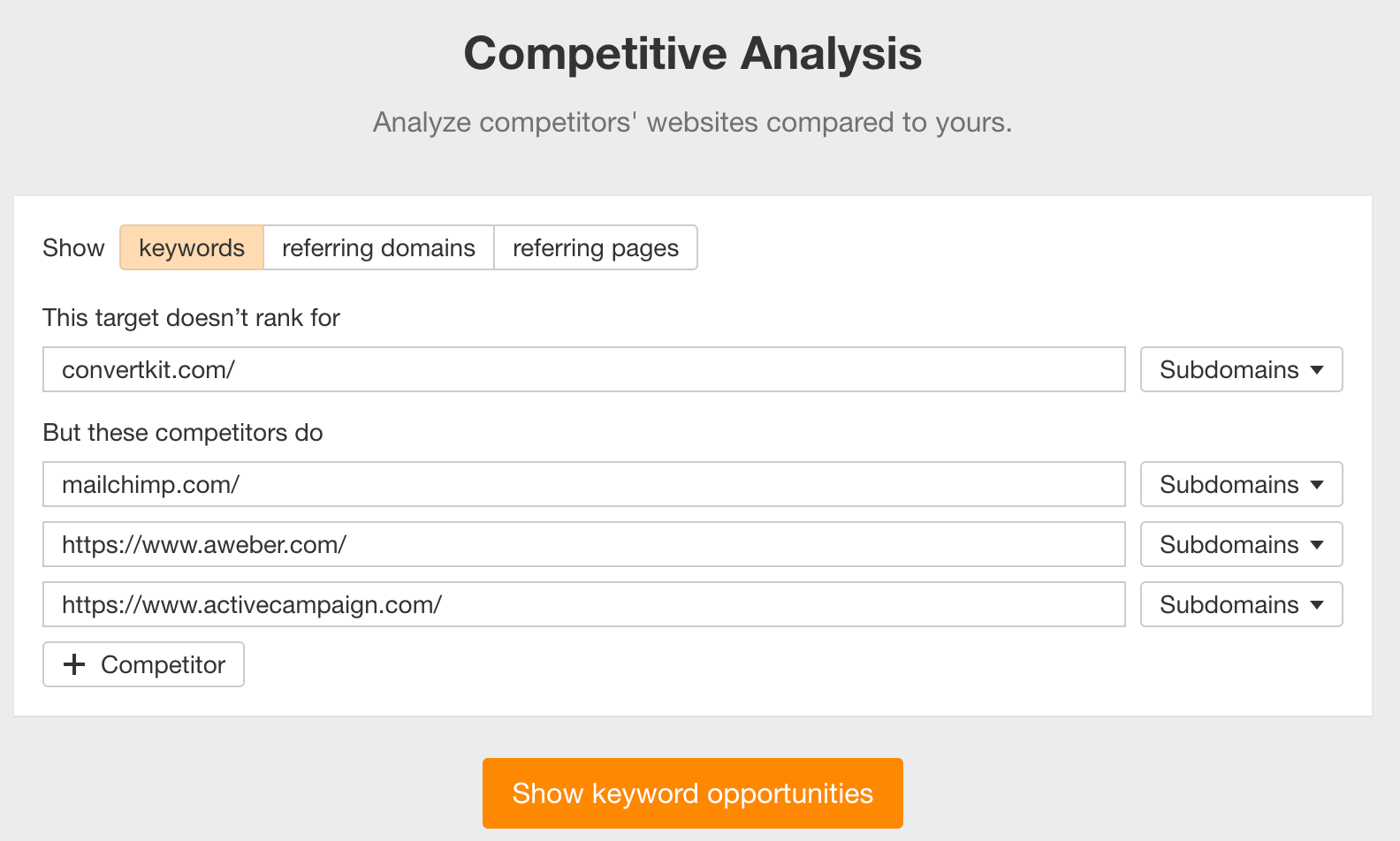

You’ll see all the keywords that at least one of these competitors ranks for, but you don’t.


You can also narrow the list down to keywords that all competitors rank for. Click on the Competitors’ positions filter and choose All 3 competitors:


- Go to Ahrefs’ Site Explorer
- Enter your competitor’s domain
- Go to the Paid keywords report
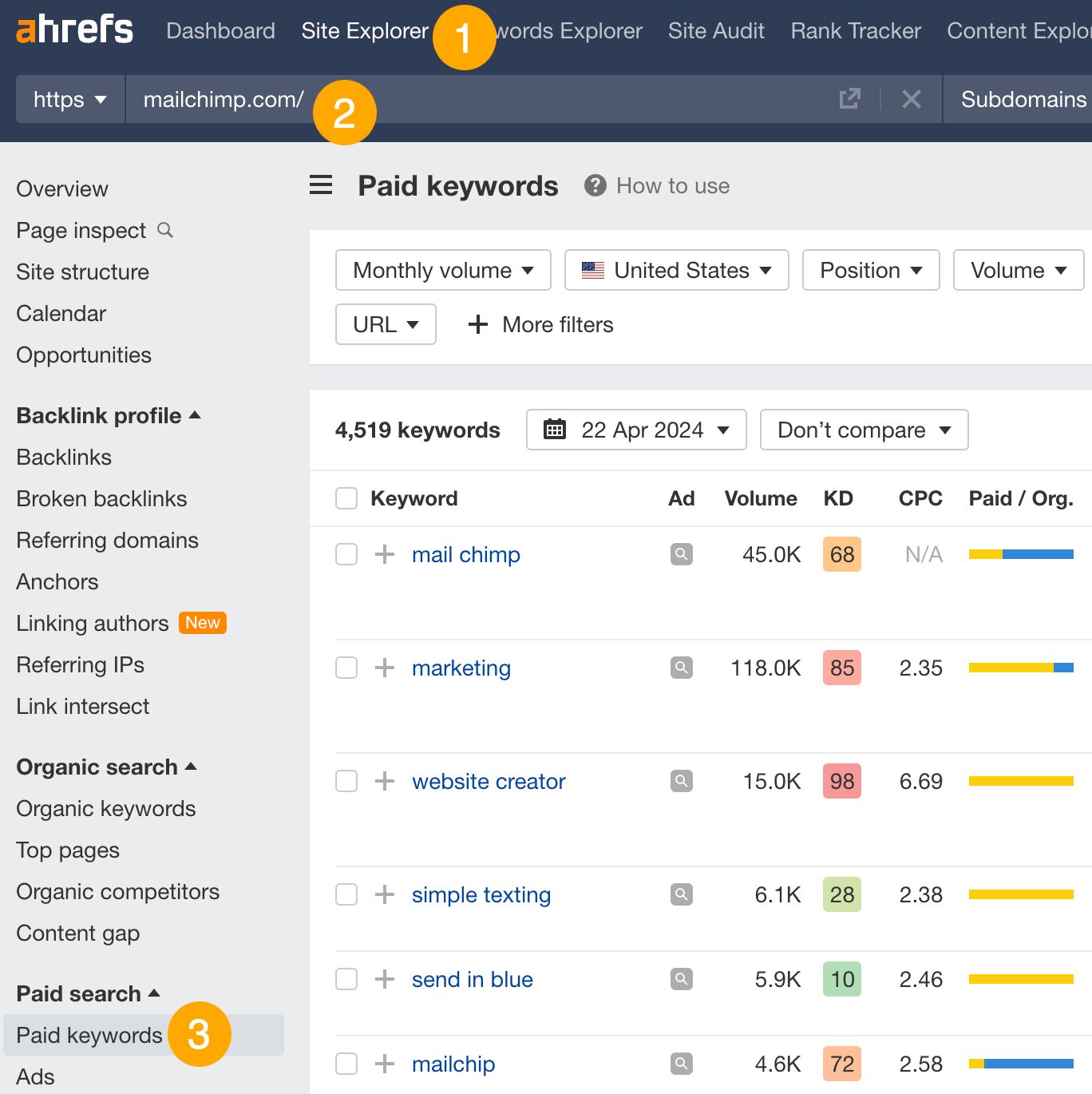

This report shows you the keywords your competitors are targeting via Google Ads.
Since your competitor is paying for traffic from these keywords, it may indicate that they’re profitable for them—and could be for you, too.
You know what keywords your competitors are ranking for or bidding on. But what do you do with them? There are basically three options.
1. Create pages to target these keywords
You can only rank for keywords if you have content about them. So, the most straightforward thing you can do for competitors’ keywords you want to rank for is to create pages to target them.
However, before you do this, it’s worth clustering your competitor’s keywords by Parent Topic. This will group keywords that mean the same or similar things so you can target them all with one page.
Here’s how to do that:
- Export your competitor’s keywords, either from the Organic Keywords or Content Gap report
- Paste them into Keywords Explorer
- Click the “Clusters by Parent Topic” tab


For example, MailChimp ranks for keywords like “what is digital marketing” and “digital marketing definition.” These and many others get clustered under the Parent Topic of “digital marketing” because people searching for them are all looking for the same thing: a definition of digital marketing. You only need to create one page to potentially rank for all these keywords.
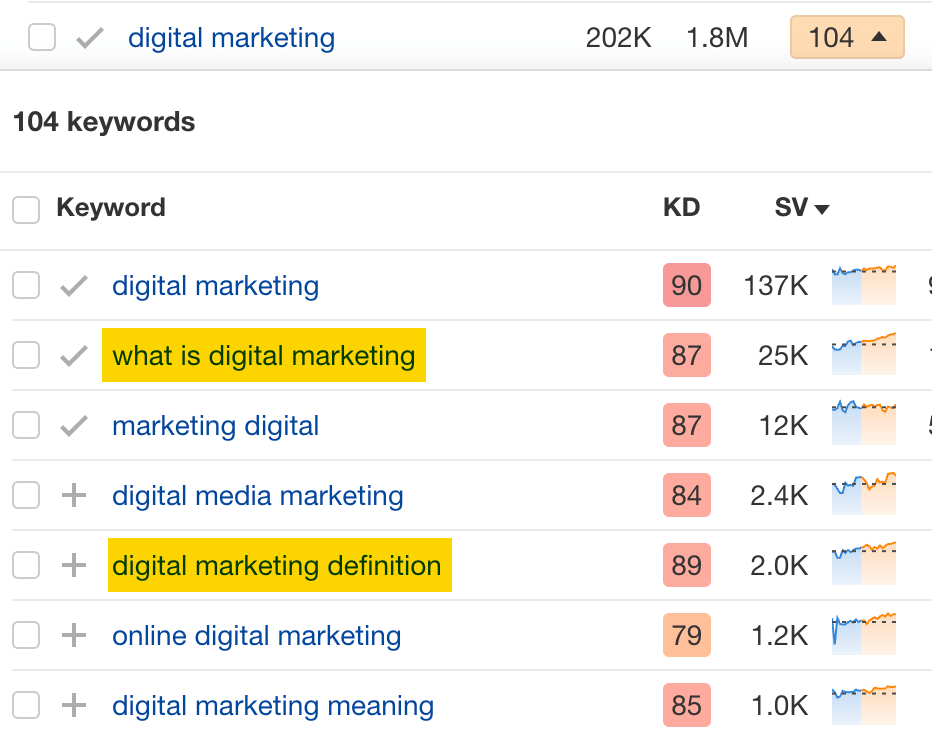

2. Optimize existing content by filling subtopics
You don’t always need to create new content to rank for competitors’ keywords. Sometimes, you can optimize the content you already have to rank for them.
How do you know which keywords you can do this for? Try this:
- Export your competitor’s keywords
- Paste them into Keywords Explorer
- Click the “Clusters by Parent Topic” tab
- Look for Parent Topics you already have content about
For example, if we analyze our competitor, we can see that seven keywords they rank for fall under the Parent Topic of “press release template.”


If we search our site, we see that we already have a page about this topic.


If we click the caret and check the keywords in the cluster, we see keywords like “press release example” and “press release format.”
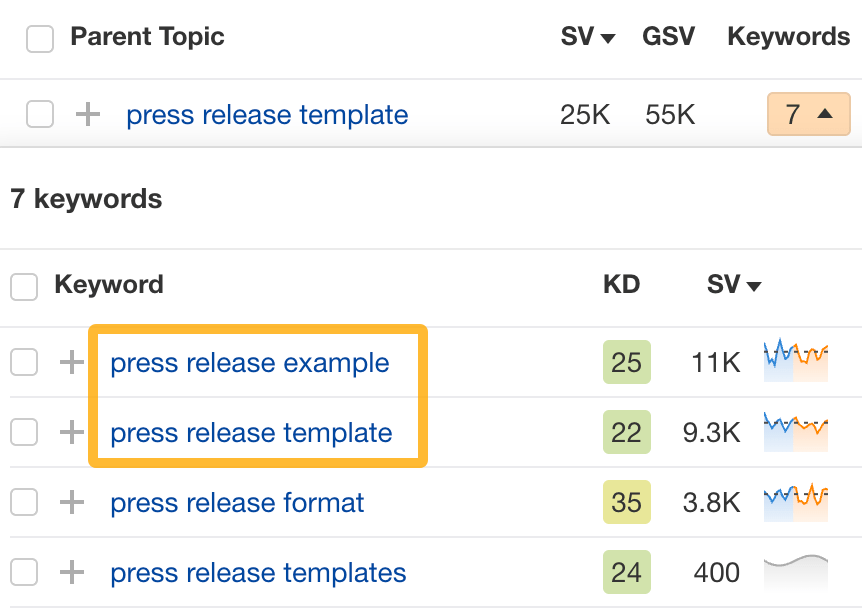

To rank for the keywords in the cluster, we can probably optimize the page we already have by adding sections about the subtopics of “press release examples” and “press release format.”
3. Target these keywords with Google Ads
Paid keywords are the simplest—look through the report and see if there are any relevant keywords you might want to target, too.
For example, Mailchimp is bidding for the keyword “how to create a newsletter.”


If you’re ConvertKit, you may also want to target this keyword since it’s relevant.
If you decide to target the same keyword via Google Ads, you can hover over the magnifying glass to see the ads your competitor is using.
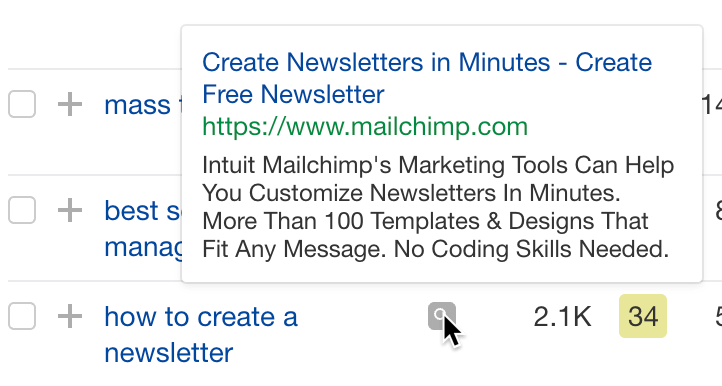

You can also see the landing page your competitor directs ad traffic to under the URL column.


Learn more
Check out more tutorials on how to do competitor keyword analysis:
-

 PPC6 days ago
PPC6 days ago19 Best SEO Tools in 2024 (For Every Use Case)
-

 MARKETING6 days ago
MARKETING6 days agoEcommerce evolution: Blurring the lines between B2B and B2C
-
SEARCHENGINES5 days ago
Daily Search Forum Recap: April 19, 2024
-
SEARCHENGINES6 days ago
Daily Search Forum Recap: April 18, 2024
-

 WORDPRESS5 days ago
WORDPRESS5 days agoHow to Make $5000 of Passive Income Every Month in WordPress
-

 SEO6 days ago
SEO6 days ago2024 WordPress Vulnerability Report Shows Errors Sites Keep Making
-

 WORDPRESS6 days ago
WORDPRESS6 days ago10 Amazing WordPress Design Resouces – WordPress.com News
-
WORDPRESS7 days ago
[GET] The7 Website And Ecommerce Builder For WordPress
















You must be logged in to post a comment Login